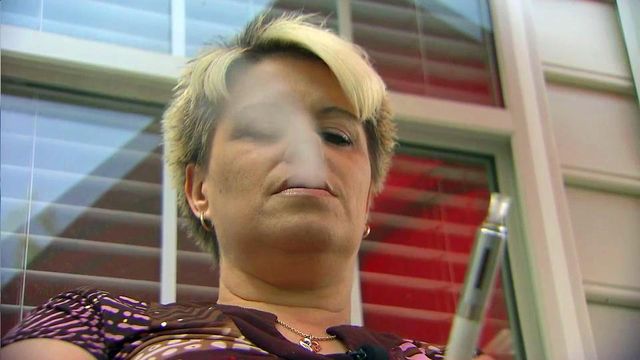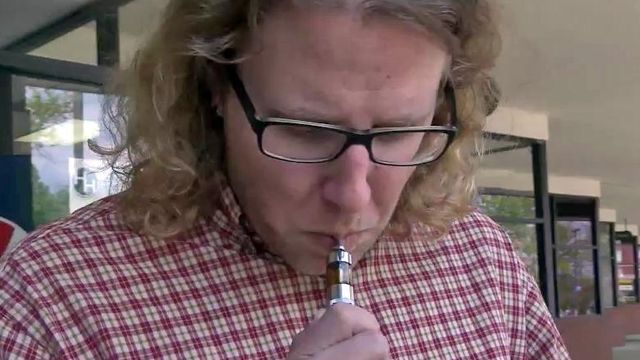Doctors differ on risk vs. reward of e-cigarettes
Sales of electronic cigarettes in the U.S. boomed from $500 million in 2012 to $1.5 billion in 2013, according to Consumer Reports, but some in the medical community differ on the risks versus possible benefits.
Posted — Updated“Vaping,” the act of inhaling the vapors of an e-cigarette’s heated liquid solution, is catching on among smokers hoping to quit the real thing. A battery heats the liquid solution containing nicotine and creates a vapor that users breathe in. What users breathe out disappears quickly and is typically odorless, unless they use flavored oil.
The health risks to those who use e-cigarettes and people around them are largely unknown because the products are not federally regulated, leaving state and municipal governments to create laws to allow or restrict their use.
New York City and Chicago recently banned e-cigarettes in restaurants and bars. In North Carolina, governments, schools and businesses make their own call.
Durham Public Schools"}}
QVape Juice in Wilson is one of the few facilities of its kind in the country that makes the liquid for e-cigarettes. The liquid is heated to produce a vapor that offers an alternative to traditional cigarette smoking, but contains fewer toxins, according to the company, which offers 40 flavors of liquids.
“That is our focus – delivering a high-quality vapor,” said CEO Sheila Williams, who worked in analytical chemistry for 16 years before starting QVape. “Just based on the chemistry, what we do know is that there are no carcinogens.”
A third of the company's e-cigarette products have no nicotine, and the highest content is labeled as 3 percent of volume. The nicotine is mixed with flavoring, vegetable glycerin and propylene glycol.
“We have our own in-house analytical lab where we test nicotine purity,” Williams said.
QVape’s 9,000-square-foot facility also includes a mixing laboratory, filling/capping laboratory, office space and labeling, packaging and warehouse areas.
The Food and Drug Administration does not regulate how e-cigarettes or the liquid are made, but Williams says she hopes that happens soon.
“There are so many people out right now making it in their basement or garage. That scares me,” she said.
Williams says she created QVape knowing that FDA regulations were inevitable, so she follows GMP, or Good Manufacturing Practices – a standard required for manufacturing food or drug products to assure safety and quality.
“We provide a certificate of analysis for every batch that we prepare and ship out,” she said.
The packaging includes a label that warns about possible birth defects and other reproductive harm. It also says to keep the liquid out of reach of children. If a child drank the candy-flavored nicotine refill bottle, it could be fatal.
QVape will soon double production from 250,000 bottles a month to 500,000. But as sales soar, many questions are still unanswered.
“What happens if you smoked this thing for 15, 20, 40 years is definitely cause for concern,” said cancer specialist Dr. Neeraj Agrawal, who works at Cancer Centers of North Carolina.
He points to known risks of nicotine, even in vapor, on the heart and in the brain, including the risk of Alzheimer’s and dementia.
“I have patients whose kids are using it,” Agrawal said. “They are getting exposed to nicotine at a very young age.”
The FDA has proposed regulations that restrict e-cigarette sales to the same age required for cigarettes.
Dr. Jed Rose, director of Duke's Center for Smoking Cessation, helped create the first nicotine patch in 1988. He says it’s important to balance concerns about the vapors from e-cigarettes with the smoke of regular cigarettes.
“My greatest concern is that it will be stamped out by excessive fears about fantastic scenarios that ‘might’ happen,” he said. “On the other hand, we do have the known 480,000 deaths per year from cigarette smoking … So, I think that we need innovative and bold new approaches to get cigarette smokers to quit.”
A study published in The Lancet last September showed that, after six months, 7.3 percent of study participants using e-cigarettes stopped smoking versus 5.8 percent using the nicotine patch.
Rose says his staff plans to study e-cigarettes as a smoking cessation tool because other nicotine replacement therapies don't work for most smokers.
“In terms of the long-term effects of inhaling those compounds, that clearly needs to be studied more,” he said.
• Credits
Copyright 2024 by Capitol Broadcasting Company. All rights reserved. This material may not be published, broadcast, rewritten or redistributed.






